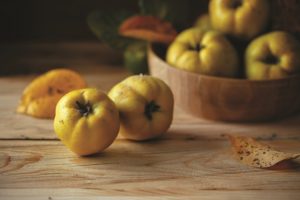Before we came to Truro, we lived in the Jamaica Plain neighborhood of Boston, where I grew salad greens and root vegetables in a community garden plot. That’s where I had my first encounter with quince.
I didn’t recognize the craggy but statuesque tree that grew next to the garden’s fence. It had single pale pink blossoms in the spring and fat knobbly fruit that ripened very late in the fall. The fruit looked to me like mutant pear. I had to ask someone what it was.
Quinces are known for their fragrance, and that is what I remember most about that neighborhood fruit. Its scent was sweeter than an apple’s or pear’s — rosy, citrusy, and intense. A bowl of them on the kitchen counter perfumed our house for weeks.
But while it freely offers its fragrance, getting flavor from a quince’s flesh requires some commitment: those grown outside tropical climates must be cooked to be eaten. In all the years I cultivated my little plot, I seemed to be the only one picking the fruit. Most of the tree’s generous production fell to the ground and rotted.

Originating in the Caucasus mountains, the quince’s culinary history stretches back to antiquity. It was likely the “golden apple” that figured so prominently in the goings-on in the Garden of Eden. The trees were introduced in North America by European settlers, becoming ubiquitous in rural yards and gardens, though eventually they fell from favor, replaced by bearers of softer, sweeter fruits that didn’t require cooking.
I hadn’t seen a quince for years until few weeks ago when, after a cross-Canada train trip, Christopher and I landed in a cottage near Point Reyes, Calif. There, right off the porch, grew an old and unpruned quince. It looked just as unloved as the one in the community garden. But even the aroma of the nearby cow pasture was no match for the unmistakable fragrance that drifted from the ripe green-golden fruit that covered the tree.
One evening I hollowed out one of the giant fruits and baked it stuffed with a paste of sugar, lemon, ginger, and cream. The flesh was made pink and silky by cooking and was every bit as delicious as I remembered — much more interesting than apples prepared the same way. A few days later I poached a second quince in some leftover merlot flavored with sugar, cinnamon stick, and whole black pepper. I boiled the poaching liquid into a syrup and poured it over the fruit.
That was it. Before we left California, I ordered a pair of two-year-old bare-root trees to plant in Truro. I see myself adding them to apple pies and making membrillo — the firm quince paste people on the Iberian Peninsula serve with cheese.
The recipe for that baked quince was adapted from one by the esteemed food writer Mimi Sheraton (whose name, were it not already taken, would be my drag name), who found it in Jane Grigson’s 1982 Fruit Book. It’s dead simple to prepare, and you’ll be shocked at what a delicious result you get with so little effort.
I don’t see quinces often in the market here but when I do, I scoop them up. I’m ready to go one step further and advocate for a comeback of this tough, prolific little tree in Outer Cape gardens. I’m still waiting for mine to be delivered. In about two years I’m sure I’ll have plenty to share.
Baked Quinces
Serves 4
4 ripe quinces
Lemon juice
1 cup sugar
½ cup unsalted butter, softened
1-inch piece of fresh ginger, peeled and grated
¼ cup heavy cream
Cream and sugar for passing, optional
- Preheat oven to 375° F and scrub any fuzz off the quinces. Peel and core them, being careful not to pierce the bottom of fruit. (This takes a little work; both a sharp paring knife and a small spoon such as a grapefruit spoon will prove useful.) Squeeze lemon juice over the quinces as you go to keep them from browning and set them in a buttered baking dish, trimming the bottoms a bit if necessary to help them stand upright.
- Knead together with your fingers 2/3 of the cup of sugar with the butter, the grated ginger, and 3 generous tablespoons of the heavy cream. Stuff quinces with the mixture; if any is left, add halfway through cooking. Sprinkle the remaining sugar on top and bake 1 hour or until quinces are tender.
- Mimi Sheraton serves with a swirl of extra cream and a sprinkling of sugar on top.



